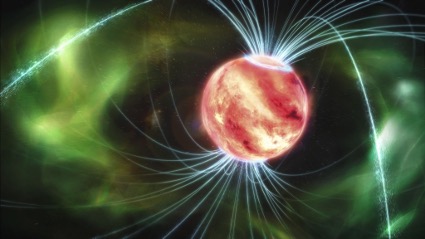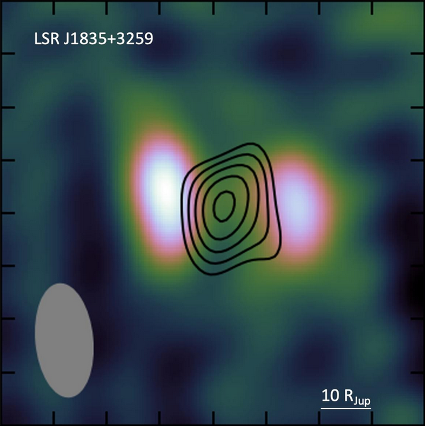
Astronomers from the Universitat de València show the first detailed image of a radiation belt outside our solar system

Astronomers from the Universitat de València captured a detailed image of the first radiation belt detected around a brown dwarf outside our solar system. The image, obtained last January and now published in the Science journal, evokes the well-known belts of Earth and Jupiter, reveals a magnetic field ten times greater than that of the largest planet in the solar system, and unlocks new secrets of these ultracool substellar objects of very low mass and very powerful radiation.
In 1958, the space scientist James Van Allen discovered that our planet was surrounded by ions and electrons trapped in Earth’s magnetic field which interfere with the communications with space probes. Almost simultaneously, giant radiation belts were serendipitously discovered around Jupiter from “bursts” detected in radio observations.
Ultracool dwarfs are stellar objects of very low mass. This is the case of the brown dwarf LSR J1835+3259 (LSRJ1835 for short), around which a team of scientists from the Universitat de València detected last January a radiation belt made up of energetic charged particles trapped in its intense magnetic field. The donut-like shape of the radiation belt is a scaled-up version of the well-known Earth’s Van Allen —named after their discoverer— and Jupiter's radiation belts. The new radiation belt of LSRJ1835, imaged at radio wavelengths using the European very-long-baseline-interferometry (VLBI) Network, is the first discovered beyond our solar system and shows the universality of this structure.
“Although with different size and energetics, the VLBI image of the radiation belt around LSRJ1835 is strikingly similar to those of the van Allen or Jupiter belts; this similarity is apparent when seen Jupiter and LSRJ1835 radiation belts side by side”, said Juan Bautista Climent, researcher at the Department of Astronomy at Universitat de València, associate of the Valencian International University, and lead author of the paper. “The diameter of the magnetic structure around the ultracool dwarf is ten times larger than that of Jupiter, and millions of times more powerful. Actually, LSRJ1835 is 60 times heavier than Jupiter, and rotates three times faster; both facts combine to originate an intense magnetic field on its surface, very similar to that irradiated in a magnetic resonance imaging device”, added Climent.
Highly luminescent auroras
But the extraordinary detail of the radio image of LSRJ1835 unveils further secrets of this object.
The study finds that, just like on Earth and Jupiter, the gigantic radiation belt of LSRJ1835 contributes to the formation of auroras near the poles of this brown dwarf. However, these extrasolar auroras generate such great energy that they become more than friendly luminescence... "These auroras release very concentrated energy at very high temperatures, which produces peaks of radio emission 10 times greater than the total emission of LSRJ1835," says José Carlos Guirado, professor of Astronomy at the Universitat de València and co-author of the article. “For the first time we have a clear image of the aurora, seen in polarized light and located halfway between the two radio spots corresponding to the belt, near the surface of LSRJ1835” –added Guirado.
Both the aurora and the radiation belt detected by Climent and his team are seen simultaneously, which provides valuable information about the geometry of this brown dwarf.
On the other hand, the extraordinary results in LSRJ1835 show that the European VLBI Network is capable of mapping radiation belts in nearby objects, paving the way to future instruments, such as the Square Kilometre Array, that would extend these studies to smaller and more remote objects, including exoplanets. The knowledge of the magnetic environment of the exoplanets is extremely important to calibrate the possibilities of hosting alien life. “Whether life is viable would strongly depend on the radiation features surrounding these new worlds“ –stressed Miguel Ángel Pérez-Torres, from CSIC’s Instituto de Astrofísica de Andalucía and co-author of the article.
LSRJ1835 is a brown dwarf, a transition body between a star and a planet located 18 light years away. LSRJ1835 is extremely small, and only the use of very long baseline interferometry (VLBI) networks allows a detailed vision of its surroundings. To obtain the image of the new radiation belt, the European VLBI Network combined giant radio antennas stretched across the globe, from Spain to Shanghai, from Sweden to South Africa, all scanning LSRJ1835 simultaneously to achieve a resolution 50 times better than that of the James Webb space telescope.

More information:
'Evidence for a radiation belt around a brown dwarf'. J. B. Climent, J. C. Guirado, M. Pérez-Torres, J. M. Marcaide, L. Peña-Moñino. https://www.science.org/doi/10.1126/science.adg6635 . DOI 10.48550/arXiv.2303.06453
Contact:
Juan Bautista Climent
Universitat de València / Valencia International University
E-mail: j.bautista.climent@uv.es
Ph: 655 39 30 08
Jose Carlos Guirado
Universitat de València
E-mail: guirado@uv.es
Ph: 629 50 91 30